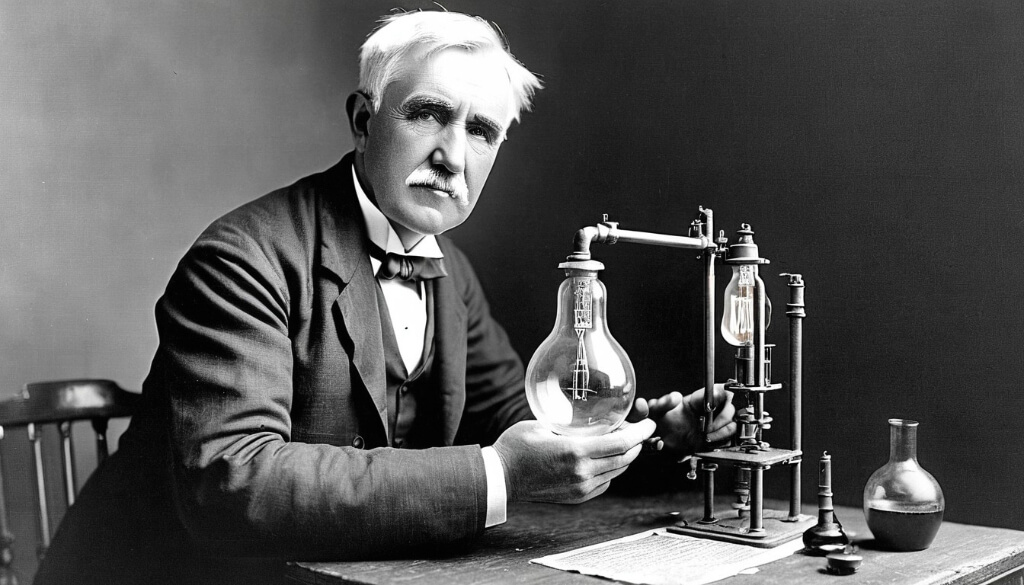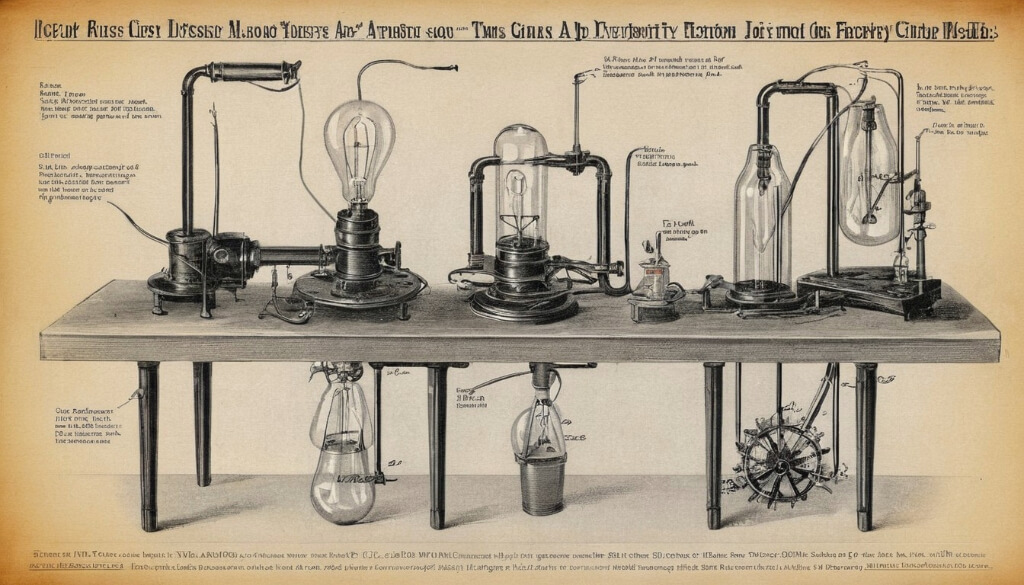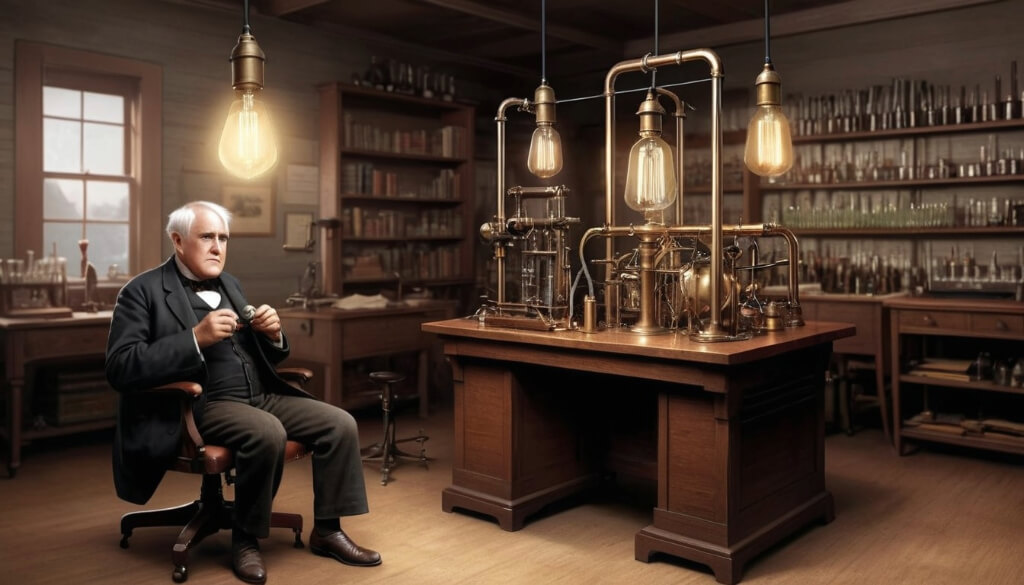Thomas Edison, a name synonymous with innovation, left an indelible mark on the world through his groundbreaking inventions. From the humble beginnings of his early life to the establishment of the renowned Menlo Park laboratory, Edison’s journey was one of relentless curiosity and entrepreneurial spirit.

In the late 19th and early 20th centuries, Thomas Edison became a beacon of ingenuity, transforming the landscape of technology and invention. His legacy, characterized by a myriad of revolutionary creations, continues to shape our modern world.
Early Life And Career
Born in 1847, Edison’s upbringing played a crucial role in shaping his inquisitive mind. His early entrepreneurial ventures set the stage for a career that would redefine the possibilities of technology. These formative years laid the foundation for Edison’s later achievements.
The Invention Factory
Edison’s Menlo Park laboratory, often referred to as the Invention Factory, stands as a testament to his commitment to innovation. This facility served as the birthplace of numerous inventions, showcasing Edison’s relentless pursuit of technological advancements. The atmosphere of creativity and experimentation within the Invention Factory became a hallmark of Edison’s approach.
Key Inventions
Thomas Edison inventions are numerous and varied, each contributing significantly to different aspects of society. The phonograph, a marvel of its time, not only revolutionized the music industry but also laid the groundwork for audio recording technologies. The electric light bulb, arguably one of Edison’s most iconic creations, transformed the way we illuminate our world, bringing about a new era of safety and convenience.
Edison’s foray into motion pictures was equally groundbreaking. His contributions to early cinematography paved the way for the evolution of the film industry. Additionally, Edison’s improvements to telegraph technology played a vital role in advancing communication systems, leaving an enduring impact.
Thomas Edison’s prolific career was marked by a series of key inventions that not only defined his legacy but also transformed the way humanity interacted with technology.
Phonograph: A Symphony Of Innovation
Edison’s groundbreaking invention of the phonograph marked a revolutionary moment in the history of audio recording. In the late 19th century, the idea of capturing and reproducing sound was a distant dream. However, Edison’s ingenuity led to the development of the phonograph, a device capable of recording and playing back sound. The impact was profound, ushering in a new era for the music industry and laying the foundation for the modern recording technologies we enjoy today.
Electric Light Bulb: Illuminating The Future
Undoubtedly, one of the most iconic Thomas Edison inventions is the electric light bulb. In a world accustomed to gas lamps and candles, Edison’s vision illuminated the darkness. Through tireless experimentation, he perfected a practical and commercially viable incandescent light bulb. This invention not only transformed the way we illuminate our homes but also contributed to enhanced safety and extended productivity. Edison’s electric light bulb became a beacon of progress, symbolizing the triumph of innovation over traditional methods.
Motion Pictures: Capturing Moments In Time
Edison’s foray into motion pictures revolutionized the entertainment industry. His kinetoscope and kinetograph inventions paved the way for the birth of cinematography. Edison’s vision allowed people to capture and witness moving images, creating a new form of storytelling. The impact of his contributions to early filmmaking is immeasurable, shaping the trajectory of an industry that continues to captivate audiences worldwide.
Telegraph Improvements: Connecting The World
Edison’s innovations were not limited to entertainment; he also played a crucial role in advancing communication systems. His improvements to telegraph technology facilitated more efficient and reliable long-distance communication. By enhancing the capabilities of the telegraph, Edison contributed to the interconnected world we now take for granted. The evolution of telegraphy under Edison’s guidance laid the groundwork for the development of future communication technologies.
In each of these key inventions, Thomas Edison showcased an ability to push the boundaries of what was thought possible. These creations not only shaped his legacy but also laid the groundwork for the technological landscape of the 20th and 21st centuries. Edison’s spirit of innovation continues to inspire generations of inventors and dreamers, reinforcing his position as a true pioneer in the realm of technology and invention.
Challenges And Failures
Edison’s path to success was not without its challenges. Setbacks and failures were inherent in his journey. Yet, it was Edison’s unique approach to adversity that set him apart. Instead of viewing failures as obstacles, he saw them as opportunities to learn and refine his inventions. This resilience played a crucial role in the development of his most significant breakthroughs.
Legacy And Impact
The legacy of Thomas Edison inventions extends far beyond the tangible products of his time. His influence on technology and innovation reverberates through the decades. The electric light bulb, in particular, remains a symbol of Edison’s ingenuity and its transformative impact on modern society.
Controversies And Criticisms
While Edison’s achievements are celebrated, they are not without controversies. Examination of his work reveals debates and criticisms, shedding light on the complexities of his contributions. The controversies surrounding some of his inventions prompt reflection on the ethical considerations inherent in the pursuit of innovation.
Thomas Edison inventions have left an enduring legacy that continues to shape our world. His insatiable curiosity, coupled with an entrepreneurial spirit, propelled him to the forefront of technological advancements. Edison’s creations not only illuminated our homes but also illuminated the path for future innovators.
Exploring Thomas Edison’s Most Revolutionary Inventions
Thomas Edison stands as one of the most influential inventors in history, renowned for his groundbreaking contributions to technology. Among his many achievements, Thomas Edison’s famous inventions have left an indelible mark on society, shaping the modern world in profound ways. In this article, we delve into the remarkable inventions that define Edison’s legacy and examine their enduring impact.
The Invention Of The Phonograph
One of Thomas Edison’s famous inventions is the phonograph, a device that revolutionized the recording and playback of sound. Inspired by the desire to capture and reproduce sound, Edison embarked on a journey of experimentation. Through relentless innovation, he succeeded in creating a device capable of preserving audio recordings. The phonograph’s invention marked a pivotal moment in communication and entertainment, paving the way for future advancements in audio technology.
The Electric Light Bulb: Revolutionizing Illumination
Before Thomas Edison’s famous invention of the electric light bulb, human civilization relied on various forms of illumination, ranging from candles to gas lamps. However, these sources of light were inefficient, costly, and often hazardous. The quest for a practical and reliable alternative led Thomas Edison to embark on one of his most famous and impactful endeavors: the development of the incandescent light bulb.
Edison’s journey to inventing the electric light bulb was fraught with challenges and setbacks. He conducted thousands of experiments, tirelessly testing different materials and designs in pursuit of a filament that could withstand high temperatures and produce long-lasting illumination. Edison famously remarked that he hadn’t failed but rather had found “10,000 ways that won’t work” before finally achieving success.
In 1879, after years of experimentation and refinement, Edison successfully created a practical incandescent light bulb. Central to its design was a thin filament made of carbonized bamboo, which could glow brightly when subjected to an electric current without burning out quickly. This breakthrough not only provided a reliable source of illumination but also laid the foundation for the widespread electrification of society.

The impact of the electric light bulb on daily life was nothing short of revolutionary. Suddenly, homes, streets, and workplaces could be illuminated with a clean, bright light at the flick of a switch. This newfound convenience and safety transformed the way people lived and worked, extending productive hours well into the night and enhancing the overall quality of life.
Moreover, the electric light bulb spurred rapid advancements in infrastructure and urban development. Cities across the globe began investing in electric power grids to bring the benefits of electric lighting to their citizens. The electricity demand led to the establishment of power plants and distribution networks, ushering in an era of unprecedented technological progress.
Beyond its practical utility, the electric light bulb also had profound cultural and societal implications. It symbolized progress, enlightenment, and modernity, becoming a beacon of hope and innovation in an increasingly industrialized world. Artists, writers, and thinkers drew inspiration from its luminous glow, capturing its significance in paintings, literature, and philosophy.
Today, more than a century after its invention, the electric light bulb remains an indispensable fixture of modern life. While advancements in lighting technology have led to the development of more energy-efficient alternatives, the legacy of Edison’s invention endures. It serves as a testament to the power of human ingenuity to overcome obstacles, illuminate the darkness, and shape the course of history.
The Motion Picture Camera: Capturing Moments In Time
In the late 19th century, as Thomas Edison continued to push the boundaries of innovation, he turned his attention to the realm of visual storytelling. Inspired by the desire to capture and preserve fleeting moments in time, Edison embarked on a journey to develop a device that could record and playback moving images. This quest led to the invention of the motion picture camera, a groundbreaking technology that revolutionized entertainment and communication.
Edison’s foray into motion picture technology was driven by his keen understanding of the power of visual imagery to captivate and engage audiences. Drawing upon his expertise in electromechanical engineering, he set out to create a device capable of capturing the continuous motion of the world around us.
In 1888, Edison unveiled his first motion picture camera, known as the kinetograph. This ingenious device utilized a series of rapidly rotating gears and a flexible filmstrip coated with light-sensitive emulsion to capture individual frames of motion. The resulting footage could then be played back at varying speeds, creating the illusion of continuous movement.
Accompanying the kinetograph was the kinetoscope, a viewing device that allowed audiences to watch recorded motion pictures. These early motion pictures, often referred to as “kinetoscopes,” offered audiences a glimpse into a world previously unseen, capturing everything from mundane daily activities to thrilling spectacles.
The invention of the motion picture camera heralded a new era of entertainment and visual storytelling. Filmmakers and innovators around the world embraced this transformative technology, experimenting with new techniques and pushing the boundaries of artistic expression. Edison’s contributions to motion picture technology laid the foundation for the modern film industry, shaping the way we document, interpret, and share our collective experiences.
Moreover, the impact of the motion picture camera extended far beyond the realm of entertainment. It revolutionized communication and education, enabling the dissemination of information and ideas through the powerful medium of film. From newsreels to documentaries, motion pictures became a powerful tool for shaping public opinion and understanding the world around us.
Today, the legacy of Thomas Edison’s famous inventions in motion picture technology continues to shape our culture and society. Advances in digital filmmaking and distribution have democratized access to the art form, allowing filmmakers of all backgrounds to share their stories with global audiences. Yet, amidst these advancements, the spirit of innovation and creativity that fueled Edison’s invention remains as potent as ever, reminding us of the profound impact that one individual can have on the course of history.
The Telegraph: Pioneering Communication
Among Thomas Edison’s famous inventions, the telegraph stands as a testament to his ingenuity in communication technology. Building upon earlier telegraph designs, Edison made significant improvements that enhanced the speed and reliability of long-distance communication. The telegraph played a crucial role in connecting people across vast distances, facilitating the exchange of information, and shaping the global communication network.
The Storage Battery: Powering The Future
Among Thomas Edison’s famous inventions, the development of the storage battery stands as a testament to his visionary approach to energy technology. While the electric light bulb illuminated homes and streets, Edison recognized the need for a reliable and portable power source to drive the machinery of the modern world. His solution came in the form of a storage battery, a device capable of storing and releasing electrical energy on demand.
Edison’s interest in storage batteries stemmed from his broader efforts to electrify society. He foresaw a future where electricity would power not only lights but also a wide range of devices, from telephones to automobiles. However, existing battery technologies of the time were bulky, inefficient, and prone to failure. Undeterred by these challenges, Edison set out to develop a better solution.
After years of experimentation and refinement, Edison introduced his groundbreaking storage battery in 1901. Unlike traditional lead-acid batteries, which relied on liquid electrolytes and were prone to leakage and corrosion, Edison’s battery used a solid electrolyte composed of alkaline chemicals. This innovation made the battery more durable, reliable, and suitable for a wide range of applications.
One of the key advantages of Edison’s storage battery was its portability. Unlike stationary power sources such as generators or power plants, the storage battery could be easily transported and deployed wherever power was needed. This versatility made it ideal for powering a variety of devices, including early automobiles, telecommunication systems, and portable electronics.
The impact of Edison’s storage battery on society was profound and far-reaching. It enabled the widespread adoption of electric vehicles, paving the way for the transportation revolution of the 20th century. Electric taxis, delivery trucks, and even experimental submarines relied on Edison’s batteries for power, offering a glimpse into a future free from the constraints of fossil fuels.
Moreover, Edison’s storage battery played a crucial role in advancing telecommunications technology. By providing a reliable source of backup power for telephone exchanges and telegraph stations, it helped ensure the uninterrupted flow of information across vast distances. This resilience was particularly important during emergencies and disasters when communication networks were most needed.
Today, the legacy of Thomas Edison’s famous inventions in storage battery technology lives on in the myriad devices that power our modern world. From smartphones to laptops to electric vehicles, rechargeable batteries have become an indispensable part of daily life. Yet, amidst these advancements, Edison’s pioneering work serves as a reminder of the importance of innovation and perseverance in shaping the future of energy. As we continue to seek sustainable and efficient ways to power our world, we would do well to draw inspiration from the ingenuity of one of history’s greatest inventors.

The Impact Of Thomas Edison’s Inventions On Society
The cumulative impact of Thomas Edison’s famous inventions on society cannot be overstated. Edison’s inventions transformed daily life, bringing light, sound, and communication to people around the world. His entrepreneurial approach and relentless pursuit of innovation laid the foundation for modern technology and industry. Today, we continue to benefit from the legacy of Edison’s genius, with his inventions shaping nearly every aspect of our lives.
Criticism And Controversies Surrounding Edison’s Work
Despite his monumental achievements, Edison’s work was not without controversy. Critics have raised concerns about his business practices, including allegations of patent infringement and unethical behavior. Additionally, disputes over the true origins of certain inventions have sparked debates among historians and scholars. While Edison’s legacy remains indisputably significant, it is essential to acknowledge the complexities and controversies that surround his work.
Final Thoughts
In conclusion, Thomas Edison’s famous inventions have left an indelible mark on the world, shaping the course of history and revolutionizing technology. From the phonograph to the electric light bulb, Edison’s inventions continue to influence and inspire generations of innovators. As we reflect on his legacy, we are reminded of the power of human ingenuity to transform the world for the better.
FAQs
What Were Thomas Edison’s Most Famous Inventions?
Thomas Edison’s most famous inventions include the phonograph, the electric light bulb, motion pictures, and improvements to telegraph technology.
How Did Edison Approach Failures In His Work?
Edison viewed failures as opportunities to learn and refine his inventions. His resilience and ability to learn from setbacks played a crucial role in his success.
What Is The Significance Of The Invention Factory?
The Invention Factory, Edison’s Menlo Park laboratory, was a hub of creativity where many groundbreaking inventions were developed. It symbolizes Edison’s commitment to innovation and experimentation.
What Were Some Of Thomas Edison’s Most Famous Inventions?
Thomas Edison’s most famous inventions include the phonograph, the electric light bulb, the motion picture camera, the telegraph, and the storage battery.
What Impact Did Thomas Edison’s Inventions Have On Society?
Edison’s inventions transformed daily life, revolutionizing communication, entertainment, and illumination. They laid the groundwork for modern technology and shaped the way we live and work today.
Was Thomas Edison Involved In Any Controversies Or Disputes Over His Inventions?
Yes, Edison’s work was not without controversy. He faced criticism for his business practices, including allegations of patent infringement and disputes over the true origins of certain inventions. Despite these controversies, his legacy as a pioneering inventor remains unparalleled.
Also Read: The Untold Story Of A Genius Inventor
